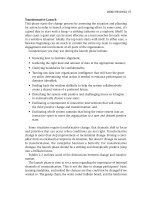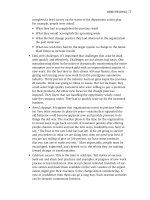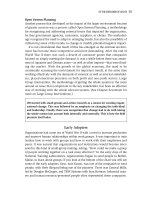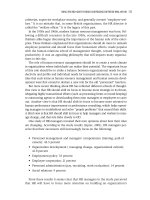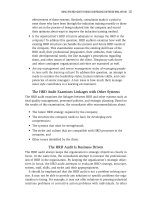Practicing Organization Development (A guide for Consultants) - Part 14 pptx
Bạn đang xem bản rút gọn của tài liệu. Xem và tải ngay bản đầy đủ của tài liệu tại đây (214.04 KB, 10 trang )
Open System Planning
Another process that developed as the impact of the larger environment became
of greater concern was a process called Open System Planning, a methodology
for recognizing and addressing external forces that impacted the organization,
be they government agencies, customers, suppliers, or clients. The methodol-
ogy recognized the need to adapt to emerging trends, but also the possibility of
influencing some of the trends, to change or modify potential negative impact.
It is not coincidental that much of this has emerged as the external environ-
ment has become more competitive and more demanding. After the end of
World War II there was such a dearth of consumer goods that companies
focused on simply meeting the demand. It was a while before there was aware-
ness of Japanese and German autos—as well as other imports—that were flood-
ing the market. With the growth of the global economy, the need to be
continually scanning the environment for important trends, at the same time
working effectively with the demands of external as well as internal stakehold-
ers, placed enormous pressures on both profit and non-profit sectors. Large
Group Intervention, the methodology of getting the whole system in the room
around an issue that is important to the key stakeholder, has been an effective
way of working with the whole relevant system. (See Chapter Seventeen for
more on Large Group Interventions.)
OD started with small groups and action research as a means for creating organi-
zational change. This was followed by an emphasis on changing the individual
and leadership. Finally, there was recognition that change had to do with taking
the whole system into account both internally and externally. This is how the field
presents itself today.
Early Adopters
Organizations had come out of World War II with a need to increase production
and improve human relationships within work groups. It was important to train
leaders how to work with groups and how to work with their employees and
peers. It was natural that organizations and institutions would become inter-
ested in this kind of small-group training, asking, “How could we make a group
of people working together on a task more effective?” In the early days of the
National Training Laboratories, organizations began to send people to Bethel,
Maine, to learn about groups. If you look at the bottom of the chart you will see
some of the early adopters. Esso, now Exxon, was one of the companies to send
people, with Herb Shepard being one of the pioneers. There was General Mills,
led by Douglas McGregor, and TRW Systems with Stan Herman. Industrial train-
ers and human resource/personnel people often represented these companies.
ON THE SHOULDERS OF GIANTS 101
08_962384 ch03.qxd 2/3/05 12:02 AM Page 101
Another institution that embraced the newly emerging field, sending selected
clergy and lay leaders to NTL laboratories, was the Episcopal Church. Their
enthusiasm spun off several organizations dedicated to spreading OD and the
applied behavioral sciences into religious settings. Early NTL-trained Episcopal
movers and shakers were Dick Byrd, David Jones, Bill Yon, and Mary Beth
Peters, who came together with Lutherans Otto Kroeger, Roy Oswald, and John
Scherer, Catholics Father Gerard Egan and Roland Sullivan, Methodists Ken
Mitchell, Bob Crosby, and Jay Olsen, and Presbyterians Newt Fink, Del Poling,
and Arnie Nakajima to launch The Association for Religion and Applied Behav-
ioral Science (ARABS) in 1969. ARABS morphed into the Association for Cre-
ative Change (ACC), which had over 1,500 members in the late 1970s.
As you move across the chart, you will note that team- and group-oriented
interventions were being used for a number of OD applications. As the civil
rights movement took off, groups were being used to sensitize people (more like
sensitivity training) to deal with issues related to race and gender. As the United
States found itself in a far more competitive market after World War II, groups
were used to emulate some of the methods being used in Scandinavia and
Japan, such as Quality of Work Life and Total Quality Management. Procter and
Gamble, in several of its plants, began experiments in self-managed teams. Team
building continues today as one of the most-used OD interventions. (See Chap-
ter Sixteen on team building.)
The increase in global teams has presented the field with some interesting
challenges, such as meshing cultural differences and working with people
spread across great geographical distances. The Internet has given birth to “vir-
tual teams” as a way of managing globally dispersed people who have a com-
mon task or project.
Most major organizations have used organization development, sometimes
calling it, as does the military, “organization effectiveness.” Some of the early
adopters have been mentioned: Esso and TRW systems, The U.S. Army, U.S.
Navy, the Chaplain’s Corps, and the Episcopal Church being among the first.
Two of the people on the bottom line of the chart—Shel Davis from TRW Sys-
tems and Cy Levi from General Mills—took the risk to bring the newly emerging
OD methodology into their organizations rather than simply sending people to
workshops. There were several external consultants who are well known in the
field, Dick Beckhard (who taught at MIT) and Herb Shepard (affiliated with
Case Western Reserve), mentioned previously. They were involved over many
years in consulting with some of these same early adopting organizations, as
well as in training the first and second generation of OD consultants.
One other important person to mention here is Ronald Lippitt, who spent his
time focusing primarily on the non-profit sector. After the downturn of the auto
industry in Michigan, Lippitt used Large Group Interventions to work with cit-
izen groups to change entire communities in Michigan. In one city he involved
102 PRACTICING ORGANIZATION DEVELOPMENT, 2ND EDITION
08_962384 ch03.qxd 2/3/05 12:02 AM Page 102
three thousand people in re-creating their community. He also built into his
work a process of focusing on a “desired future,” rather then spending time
solving tactical problems. Once you knew where you were and where you
wanted to be, you could strategize how to close the gap. One important and
less-well-known piece of his research showed what happened to a group’s
energy when they focused on problems (it tended to sag) and when they
focused on what was working that could be improved (it grew). Appreciative
inquiry is based in part on this premise. Lippitt also was one of the first to pos-
tulate the phases in the consulting process, something every OD consultant today
knows like a favorite bedtime story. See Chapter Five on competencies to view
Ron and Gordon Lippitt’s integration with Lewin’s famous change model. Lewin
believed that a successful change effort includes three aspects; unfreezing, if
necessary the current state; moving to higher, more positive level; and freezing
the system one is changing at the new state.
A WORKING DEFINITION OF OD
“Please, give me a nice clean definition of OD!” We have heard this asked so
many times. Every practitioner has his or her own definition. Here are several:
• “Organization development is a long-term effort led and supported by
top management, to improve an organization’s visioning, empower-
ment, learning, and problem-solving processes, through an ongoing, col-
laborative management of organizational culture—with special
emphasis on the consultant-facilitator role and the theory and technol-
ogy of applied behavioral science, including participant action research”
(French & Bell, 1999).
• “OD is an organization-wide effort, managed from the top, to increase
an organization’s effectiveness and health through planned interven-
tions in the organization’s processes, using behavioral science knowl-
edge” (adapted slightly from Beckard, 1969).
• Here is ours: “OD is the application of behavioral science action
research and systems theory to human systems, to increase the internal
and external effectiveness of the organization, especially in managing
change, using participative processes that involve all those affected.”
We are standing on the shoulders of giants. It is now up to us, their descen-
dants, to do what they did so many years ago: discover new principles and
methods of assisting leaders and their organizations to be as effective as they
can be.
ON THE SHOULDERS OF GIANTS 103
08_962384 ch03.qxd 2/3/05 12:02 AM Page 103
End Notes
1. Many colleagues contributed to this chapter, among them Warner Burke, John
Adams, Saul Eisen, Edie Seashore, Denny Gallagher, Marvin Weisbord, and others.
We have drawn heavily from Weisbord’s wonderfully rich, easy-to-read, and well-
documented description of the origins of our field in Productive Workplaces (1987).
2. Hundreds of people have contributed to this field. Regrettably, space does not
permit all the contributors to be mentioned. We have had to make choices and
apologize to those who do not find their names listed.
3. See Alfred Marrow’s very thorough and very readable biography of Lewin, The
Practical Theorist (1969).
4 Personal conversation between John Scherer and Ron Lippitt—who was in the
room as one of Lewin’s research assistants at this birth of the T-group.
5 See Bradford et al. (1964) for a more thorough description.
6. As Weisbord points out, Roger Harrison’s “role negotiation” was a major pro-
grammatic step in reducing the threat of team building. John and Joyce Weir got
rid of interpersonal feedback entirely in their self-differentiation labs. The inven-
tion of “percept language” made it possible for people to provide feedback to
themselves while using others as projection screens.
7. We would like to settle two unsettling questions that have been dogging our field
for years: Who named OD? and What does “OD” actually stand for? Who named
OD, Herb Shepard or Dick Beckhard? The friendly debate has “raged” for years,
but we are hereby putting it to rest. In 1974 Larry Porter, long-time editor of The
OD Practitioner, sat down and conducted an interview with both of them, during
which he raised the question (Porter, 1974). As Larry reported it in a tongue-in-
cheek footnote, “They created this response ‘for the record’—prompted by Herb’s
elfin sense of humor: ‘Both Herb Shepard and Dick Beckhard are OD consultants
of the external persuasion. After some discussion among the three of us as to
who did what, we agreed that I (Larry) would identify them as follows in the arti-
cle: Dick Beckhard, while consulting at General Electric in 1957, invented the
term organization development. Herb Shepard, while consulting at Esso in 1957,
invented the term organization development.’—Ed.”
The proper full name for OD—at least in so far as the original co-namers
intended—is “Organization Development” and not “Organizational Develop-
ment.” The incorrect linguistic version probably came out of the early emphasis
on personal development described above. There. That should do it.
8. Marvin Weisbord is one of the most prolific writers and innovators in the field of
OD. His books, especially Productive Workplaces (1987) and Discovering Common
Ground (1992), are now classics, and he is the co-creator of the Future Search
process (2000).
9. This time-line, developed by Billie Alban, is being published here for the first time.
10. There had been other experiments, such as at ESSO Texas, which involved
putting almost everybody through stranger T-groups. It was an abject failure.
Nothing changed. The key, it turned out, was shifting to T-groups where the
entire team participated together.
104 PRACTICING ORGANIZATION DEVELOPMENT, 2ND EDITION
08_962384 ch03.qxd 2/3/05 12:02 AM Page 104
References
Beckhard, R. (1969). Organization development: Strategies and models. Reading, MA:
Addison-Wesley.
Bennis, W. (1966). Changing organizations: Essays on the development of human orga-
nizations. New York: McGraw-Hill.
Bion, W. (1940). The war of nerves. In Miller & Crichton-Miller (Eds.), The neuroses in
war. London: Macmillan.
Bradford, L., Gibb, J.R., & Benne, K.D. (Eds.) (1964). T-group theory and laboratory
method. New York: John Wiley & Sons.
Bunker, B., & Alban, B. (1997). Large group interventions: Engaging the whole system
for rapid change. San Francisco: Jossey-Bass.
Cooperrider, D., Barrett, F.J., & Srivastva, S. (1995). Social construction and apprecia-
tive inquiry: A journey in organizational theory. In D. Hosking, P. Dachler, & K.
Gergen (Eds.), Management and organization: Relational alternatives to individual-
ism. Aldershot, UK: Avebury Press.
Cooperrider, D.L., & Srivastva, S. (1990). Appreciative inquiry in organizational life. In
R. Woodman & W. Pasmore (Eds.), Appreciative management and leadership: The
power of positive thought and action in organizations (pp. 129–169). San Francisco:
Jossey-Bass.
French, W.L., & Bell, C.H. (1999). Organization development: Behavioral science interven-
tions for organization improvement (6th ed.). Upper Saddle River, NJ: Prentice Hall.
Herzberg, F., Mausner, B., & Snyderman, B. (1959). The motivation to work (2nd ed.).
New York: John Wiley & Sons.
Johnson, B. (1996). Polarity management: Identifying and managing unsolvable prob-
lems. Amherst, MA: HRD Press.
Katz, D., & Kahn, R.L. (1966). The social psychology of organizations. New York: John
Wiley & Sons.
Lawrence, P., & Lorsch, J. (1969). Developing organizations: Diagnosis and action.
Reading, MA: Addison-Wesley.
Marrow, A. (1969) The practical theorist: The life and work of Kurt Lewin. Annapolis,
MD: BDR Learning Press.
Maslow, A. (1965). Eupsychian management: A journal. Homewood, IL: Richard D. Irwin.
McGregor, D. (1960). The human side of enterprise. New York: McGraw-Hill.
Sashkin, M. (1980, June). Interview with Eric Trist, British interdisciplinarian. Group &
Organization Studies, pp. 144–166.
Srivastva, S., & Cooperrider, D.L. (1986). The emergence of the egalitarian organiza-
tion. Human Relations, 39(8), 683–724.
Taylor, F. (1915). The principles of scientific management. New York: Norton.
Weisbord, M. (1987). Productive workplaces. San Francisco: Jossey-Bass.
Weisbord, M. (1992). Discovering common ground. San Francisco: Berrett-Koehler.
Weisbord, M., & Janoff, S. (2000). Future search. San Francisco: Berrett-Koehler.
ON THE SHOULDERS OF GIANTS 105
08_962384 ch03.qxd 2/3/05 12:02 AM Page 105
CHAPTER FOUR
Using the HRD Audit to Build Convergence
Between Human Resource Management and
Organization Development
T.V. Rao and William J. Rothwell
A
ccording to thought leaders in the human resource management (HRM)
and the organization development (OD) fields (see Costello, Limbrick,
Towle, & Warner, 2002), HRM and OD are—or at least should be—
converging (Sicard, Sicard Associates, Frank, & Insights, 2002). Convergence means
that the two fields are coming together. HR practitioners are increasingly expected
to act like OD practitioners by effecting culture change and unleashing worker cre-
ativity (McBain, 2001), and, conversely, OD practitioners must increasingly become
knowledgeable about HR if they are to be most successful in helping their clients.
In making this point about the convergence of the fields, Sammut (2001, p. 9)
writes:
“Human resources (HR) and organization development (OD) share similar roots
in the human aspect of organizations. In the past, distinct differences between
HR and OD served to clearly differentiate the two disciplines. However, as each
discipline has evolved, the differences between them have diminished. Cur-
rently, the fields of HR and OD are blurred, with no evident dividing line draw-
ing distinction between these two disciplines.”
In this chapter we address the following important questions:
• What are personnel management and human resource management?
• What do practitioners in the HR field traditionally do, and how are their
roles changing?
106
∂
∂
09_962384 ch04.qxd 2/3/05 12:01 AM Page 106
• What is organization development?
• What do practitioners in the OD field traditionally do, and how are their
roles changing?
• Why are the two fields converging, and what are the implications of that
convergence?
• How could HR and OD practitioners work together to realize the bene-
fits of synergy by using an HRD audit?
WHAT ARE PERSONNEL MANAGEMENT AND
HUMAN RESOURCE MANAGEMENT?
Personnel management means the traditional administrative functions of keep-
ing personnel records and managing an employer’s payroll. It is tactical in focus.
It is also compliance-oriented, focused on ensuring employer compliance with
governmental laws, rules, and regulations and employee compliance with an
employer’s policies and work rules.
Human resource management (HRM) is more strategic in its orientation than
personnel management. It includes personnel management but goes beyond it
to ensure that the organization’s people are recruited, selected, managed, and
developed in line with the organization’s strategic objectives. Human resource
management includes such people-oriented functions as:
• Human resource planning;
• Employee recruitment;
• Employee selection;
• Employee orientation;
• Work analysis;
• Competency assessment;
• Training;
• Career management;
• Performance management;
• Compensation management;
• Benefits management;
• Health and safety;
• Employee communications; and
• Labor relations.
USING THE HRD AUDIT TO BUILD CONVERGENCE BETWEEN HRM AND OD 107
09_962384 ch04.qxd 2/3/05 12:01 AM Page 107
The traditional foundation of all HR is usually work analysis and its product,
the job description and job specification. However, many leading organizations
are moving away from that foundation, basing HR instead on competencies so
as to reap the possible differences in productivity between exemplary and aver-
age performers in every job level and category (Dubois & Rothwell, 2004).
In the HR field, it is common to distinguish between human resource man-
agement (HRM), which is broadest in its orientation and addresses all issues
about people, and human resource development (HRD), which focuses on
increasing individual and group productivity through learning (Brown, 2003).
HRM emphasizes the utilization of existing people in their current jobs. HRD
emphasizes the preparation of people for new roles, new jobs, their development
in the current roles and for unleashing the creative potential of human beings.
WHAT DO PRACTITIONERS IN THE HR FIELD TRADITIONALLY
DO, AND HOW ARE THEIR ROLES CHANGING?
HR roles have been changing for some time. Historically, of course, HR practi-
tioners have been expected to fill different roles in their organizations. Often,
those roles have changed as management philosophies changed and have also,
on occasion, conflicted (Rothwell, Prescott, & Taylor, 1998). However, numer-
ous, recent competency studies have demonstrated the requirements for suc-
cess in the HR field (for instance, see “Five key competencies,” 2003; “More on
what CEOs want from HR,” 2003; Orr, 2001; Wright, 2001).
Today’s HR professionals often have been depicted as dramatically different
from the past. For example, they are expected to focus on and guarantee deliv-
erables from deployment of HR practices that create value for their organiza-
tion; develop organizational architectures and use them to translate strategy into
action; perform organizational diagnosis by applying their organizational archi-
tectures to set organizational priorities; reengineer HR work through the use of
technology, process reengineering teams, and quality improvements; be the
employees’ voice in management discussions, ensuring that employees feel that
their issues have been heard; and be catalysts, facilitators, and designers of both
cultural change and capacity for change, establishing a vision for the HR func-
tion that excites clients and engages HR professionals (Ulrich, 1997).
The six challenges for HR professionals outlined by Ulrich (1997) and his list
of competencies indicate the closeness of HRM and OD. The six challenges are
listed and described below.
HR Theory. HR professionals must master the theory behind HR work. Theo-
ries of learning, motivation, and organizational change should lay the foundation.
108 PRACTICING ORGANIZATION DEVELOPMENT, 2ND EDITION
09_962384 ch04.qxd 2/3/05 12:01 AM Page 108
HR Tools. Improvements must continue in HR core technologies such as exec-
utive development, recruiting and staffing, training and education, rewards and
recognition, performance management, employee relations, labor relations, and
diversity. Five HR tools will become critical for the future: (1) global HR (focus-
ing on the ramifications for HR of global business strategy); (2) leadership depth
(defining and creating leaders for the future); (3) knowledge transfer (creating
systems that will transfer knowledge throughout the organization to reduce cycle
time and increase innovations and quality decisions); (4) cultural change; and
(5) customer-focused HR.
HR Capabilities. The new HR capabilities should include, in addition to the
traditional ones, the following:
• Speed: Doing HR work quickly without sacrificing quality;
• Implementation: Turning ideas into actions;
• Innovation: Thinking creatively about problems; and
• Integration: Linking customer goals, strategic plans, and employee needs.
HR Value Proposition. The HR investments in the future must focus on value
creation and developing a value equation for HR services and products. HR
practices affect employees in terms of their morale, commitment, competence,
and retention; customers in terms of their retention, satisfaction, and commit-
ment; and investors in terms of profitability, cost, growth, cash flow, and
margin.
HR Governance. HR professionals must improve how work is coordinated.
HR Careers. HR professionals may work in one of four locations: site (plant);
business unit (product line or country); corporate HR; or outside the HR func-
tion. He or she may be a specialist or a generalist, and he or she may be a con-
tributor (working alone), integrator (coordinating the work of others), or a
strategist (directing policies and procedures).
Key HR competencies include the following:
• Knowledge of business (financial capability, strategic capability, techno-
logical capability);
• Knowledge of HR practices (staffing, development, appraisal, rewards,
organizational planning, communication, and so forth);
• Management of change (creating meaning, problem solving, innovation
and transformation, relationship influence, and role influence);
USING THE HRD AUDIT TO BUILD CONVERGENCE BETWEEN HRM AND OD 109
09_962384 ch04.qxd 2/3/05 12:01 AM Page 109
• Business mastery (knowing the business, financial, strategic, technologi-
cal, and organizational capabilities of the organization);
• Human resource mastery;
• Change and change process mastery; and
• Personal credibility (accuracy in all HR work; consistency or being pre-
dictable; meeting commitments or doing what is promised on time and
within budget; being personally comfortable with colleagues, subordi-
nates, and supervisors; confronting appropriately; integrity; thinking
outside the box; confidentiality; and listening to and focusing on the
executive problems).
Personnel management, the predecessor of HR management, was born with
the advent of government laws, rules, and regulations that affect organizations.
In the United States, that began during World War I when employers were first
required by government to track payrolls and keep personnel records. In Europe,
it started even earlier (Bouchez, 1992). At the time, the dominant management
philosophy was Scientific Management, based on the work of Frederick Taylor.
Taylor advocated establishing clear distinctions between managers and work-
ers and rewarding people in line with their contributions. These early views of
management led personnel managers of that time to focus attention on estab-
lishing job descriptions and devising rational pay systems.
For the most part, it is fair to say that, in the earliest role of personnel man-
agement, practitioners were expected to function as clerks who would track pay-
roll, track benefits, and build record-keeping systems to track employers’ actions
with workers. That led to the role of paper shuffling administrator, a part still
played by HR practitioners in many organizations to this day. It also related to
the HR practitioner’s role as compliance officer, one who ensures that the orga-
nization’s managers and employees function in ways that are legal. A compli-
ance officer acts to make sure that the organization abides by the law.
Following the Hawthorne studies, personnel managers found themselves fac-
ing a new view: their role should be to maintain, or improve, good morale in their
organizations. That was an important impact of the so-called human relations view
of management, which followed Scientific Management. One key lesson of the
Hawthorne studies was that people perform better when someone pays attention
to them. While subsequent critics have questioned the value of the Hawthorne
studies because the research designs may have been flawed, their impact seems
clear. Personnel managers became the social directors of their organizations. They
were expected to lead efforts to get people to work together more effectively by
paying attention to them as people and the social side of the business.
The impact of that role today on HR is still apparent. HR is often tasked to
lead company picnics and other social events, track employee morale through
attitude surveys, address issues centering on employee wellness, manage
110 PRACTICING ORGANIZATION DEVELOPMENT, 2ND EDITION
09_962384 ch04.qxd 2/3/05 12:01 AM Page 110





